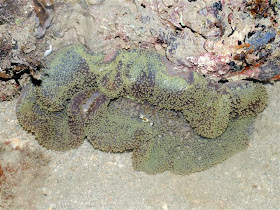The first official intertidal survey of the Southern Expedition as part of Comprehensive Marine Biodiversity Survey took place this morning at Terumbu Semakau.
Being the first trip of the low tide series, this simply means that we have to set off at 3am and the trip ended with first light from the sunrise. Though it was totally "zombifying" to survey the reefs at such an
unearthly hour, we all would agree that it was all worthwhile as we
found quite a number of fantastic finds.
I have been seeing this Smooth red sea cucumber (Actinopyga sp.) for quite a number of times for recent surveys and this individual is the biggest I have came across. Hopefully the scientists would be able to shed some light as to which species does this cucumber belong to.
The reef octopus come out to play at night at all sorts of places including among the tentacles of the soft coral.
Here's another one exhibiting its long arms as it glides across from point to point with varying patterns to camouflage itself (though this one is not very camouflaged haha).
The representative hard corals of this shore are still doing well.
Beneath huge boulders at where dark corners are found are excellent places to find the Cave corals (Tubastrea sp.)! Some of their tentacles actually droop out from the coral skeleton. It looks quite comical to me.
The minefield of Branching Montipora corals (Montipora sp.) in the middle of the reef is a hot spot nursery for all sorts of marine life. Just one small colony of the coral, you can already find so many Fan-bellied filefish (Monacanthus chinensis)!
I was excited to find this Tiger-tailed seahorse (Hippocampus comes) with distinct black and yellow bands by the reef edge. It is really handsome!
Joo Yong later showed me her find of a yellow version that is much smaller.
We were keen to show Dr Daphne (sea anemone expert) the Merten's carpet anemone (Stichodactyla mertensii) and I was glad to find two on the trip. Ria later found another one!
The Merten's carpet anemone has shorter tentacles that densely cover the oral disk. It also has colourful bumps on its body column.
There was an anemone shrimp (Periclimenes brevicarpalis) on the anemone.
Can you see what I saw in this photo? There is actually an anemone with near transparent tentacles.
Here's another look at the same anemone with the body column out of the sand.
The photo on the left shows the base and the right side shows the delicate body column with pointy projections. I shared this find with Dr Daphne and she thinks it is a sea anemone than a cerianthid. I hope it was a good find!
Wow! A huge Cushion star (Culcita novaeguinea) which I didn't get to find on our previous trip here last month.
Ria later found a special sea star, which is the orange Asterina-looking sea star that we have been seeing occasionally on our southern shores. It is also with much hope that this fellow can be identified by the echinoderm scientists on the Southern Expedition team.
A rare crabby find would be this Domed elbow crab (Cryptopodia fornicata) that we have only seen on our northern shores.
This crab is so flat that the underside also looks different from the usual bulkier crabs.
Chay Hoon found this unusual blob that made us wonder if this is the Naked moon snail or simply a type of sea slug.
This is the underside of the blob. Could it be related to the Philine sp. slug?
Seldom found on southern shores but common in the north, I think this Miliaris cowrie (Cypraea miliaris) that was found by Chay Hoon is a first record for Terumbu Semakau.
Good to see many of the usual interesting marine critters on this shore and it is with much anticipation that the Southern Expedition field trips would allow us to better understand our marine biodiversity.






















No comments:
Post a Comment